Officially the Democratic Socialist Republic of Sri Lanka, is an island country in the northern Indian Ocean off the coast of South India in South Asia. Known until 1972 as Ceylon(/sɨˈlɒnˌ seɪ-ˌ siː-/), Sri Lanka has maritime borders with India to the northwest and the Maldives to the southwest.
Since Sri Lanka is a tropical country, you can expect the rain anytime of the year in most parts. However, the two major rainy seasons are North-East monsoon (October to January) and South-West monsoon (May to July). Being an island, the climate of Sri Lanka changes dramatically from one part of the country to another. For example at Nuwara Eliya, in the hills of Central Sri Lanka, has a temperature around -5-20°C throughout the year, whereas Hambanthota, located in the dry zone, has a temperature consistently around 30-35°C.
Several languages are spoken in Sri Lanka within the Indo-Aryan, Dravidian and Austronesia families. Sri Lanka accords official status to Sinhala and Tamil. The languages spoken on the island nation are deeply influenced by the languages of neighboring India, the Maldives and Malaysia. Arab settlers and the colonial powers of Portugal, the Netherlands and Britain have also influenced the development of modern languages in Sri Lanka.
Sri Lanka is an island in the Indian Ocean also called Ceylon and many other names. It is about the size of Ireland. It is about 28 kilometers (18 mi.) off the south-eastern coast of India with a population of about 20 million. Density is highest in the south west where Colombo, the country's main port and industrial center, is located. The net population growth is about 0.7%. Sri Lanka is ethnically, linguistically, and religiously diverse.
Sri Lanka's population practices a variety of religions. As of the 2011 census 70.2% of Sri Lankans were Theravada Buddhists, 12.6% were Shaivite Hindus, 9.7% were Muslims and 7.4% Christians (6.1% Roman Catholic and 1.3% other Christian). In 2008 Sri Lanka was the third most religious country in the world by according to a Gallup poll, with 99% of Sri Lankans saying religion is an important part of their daily life.
Sri Lankan cuisine has influences from colonial powers, foreign traders and the Kerala region of India. Key ingredients are rice, coconut and especially spices, reflecting the island's history as a spice producer and trading post over several centuries. Dishes include rice and curry, pittu, Kiribath, wholemeal Roti, String hoppers, wattalapam (a rich pudding of Malay origin made of coconut milk, jaggery, cashew nuts, eggs, and spices including cinnamon and nutmeg), kottu, and hoppers. Jackfruit may sometimes replace rice. Traditionally food is served on a plantain leaf.
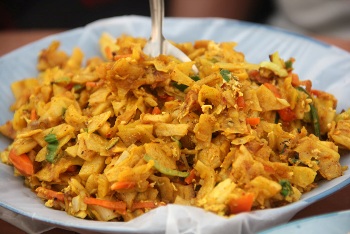
1. Kottu:
Kottu is a spicy Sri Lankan stir-fry of shredded roti bread with vegetables, optionally with other ingredients such as egg, meat or cheese.
2. Hoppers:
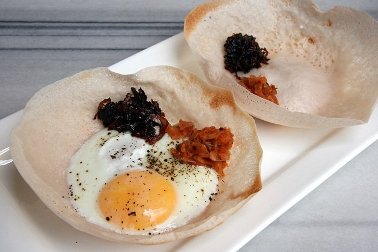
Hoppers (appa) are a range of dishes based on a fermented batter, usually of rice flour and coconut milk with spices, that is pan fried or steamed. The fermenting agent is palm toddy or yeast. Hopper variants can be either savoury, such as egg hoppers, milk hoppers, string hoppers, or sweet such as vandu appa and pani appa. Savoury hoppers are often accompanied by lunu miris, a mix of red onions and spices.
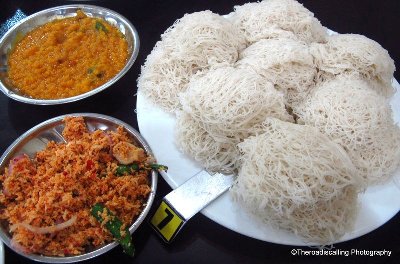 3. String Hoppers:
3. String Hoppers:
String hoppers (idiyappa) are made from hot-water dough of rice meal or wheat flour. This is pressed out in circlets from a string mould onto little wicker mats, then steamed.
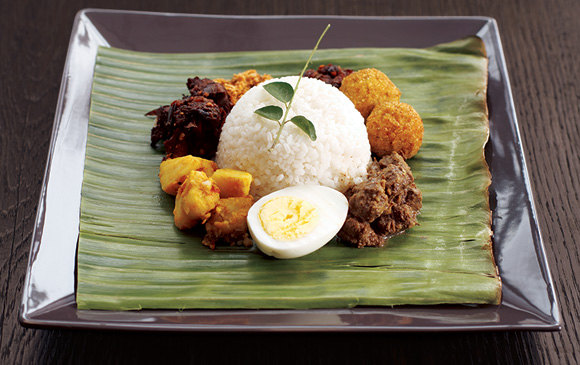 4.Lamprais:
4.Lamprais:
Lamprais is rice boiled in stock with a curry, accompanied by "frikkadels" (frikadeller meatballs), all of which is then wrapped in a banana leaf and baked in an oven. It is a Dutch-influenced Sri Lankan dish.
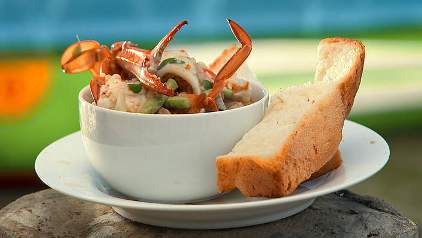 5. Kool:
5. Kool:
Kool is a seafood broth from Jaffna with crab, fish, cuttlefish, prawns and crayfish with long beans, jak seeds, manioc, spinach andtamarind. The dish is thickened with palmyra root flour.
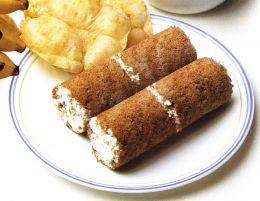 6. Pittu:
6. Pittu:
Pittu are cylinders of steamed rice mixed with grated coconut.
7. Roti:

Gothamba ma Roti is a simple Sri Lankan flat-bread usually made from wheat flour. A variant is Thengappu (Pol in Sinhalese) Roti, in which shredded coconut is mixed into the dough. Uraippu Roti (Spicy Roti) is another variant, in which chopped onions and green chillies are used when making the dough.
1- The Pinnawala Elephant Orphanage:
The Pinnawala Elephant Orphanage is situated northwest of the town of Kegalle, halfway between the present capital Colombo and the ancient royal residenceKandy in the hills of central Sri Lanka. It was established in 1975 by the Sri Lanka wildlife department in a 25 acre coconut property near the Maha Oya river. The orphanage was originally founded in order to afford care and protection to the many orphaned Elephants found in the jungle. As of 2003, there were 65 elephants.
2- Nuwara Eliya:
is a city, in the hill country of the Central Province, Sri Lanka. The city name meaning is "city on the plain (table land)" or "city of light". The city is the administrative capital of Nuwara Eliya District, with a picturesque landscape and temperate climate. It is located at an altitude of 1,868 m (6,128 ft) and is considered to be the most important location for Tea production in Sri Lanka. The city is overlooked by Pidurutalagala, the tallest mountain in Sri Lanka.
3- Kandy City Tour:
Kandy is considered the capital of Sri Lanka’s hill country and there are several interesting places and sights for tourists to visit. The city tour includes a visit to the famous ‘Dalada Maligawa’ (Temple of the Tooth Relic), the main Kandy Market, a spice garden, the gem museum and other interesting places. You will also see the beautiful manmade Kandy Lake which is located close to the Temple. The Botanical Gardens in Peradeniya will no doubt be one of the highlights as it will give you many hours of pleasurable and educational wandering through its massive acreage.
4- Galle City Tour:
Tour Operates daily. This tour takes you to visit a traditional mask-carving center at Amblangoda. Proceed to Hikkaduwa, famous for it's good beaches, surf & beautiful coral. The highlight of the tour is the Dutch fort in Galle. Have your lunch at hotel and return to Colombo.
5- Dambulla cave temple: :
also known as the Golden Temple of Dambulla is a World Heritage Site (1991) in Sri Lanka, situated in the central part of the country. This site is situated 148 km east of Colombo and 72 km north of Kandy. It is the largest and best-preserved cave temple complex in Sri Lanka. The rock towers 160 m over the surrounding plains.There are more than 80 documented caves in the surrounding area. Major attractions are spread over 5 caves, which contain statues and paintings. These paintings and statues are related to Lord Buddha and his life.
6-Sigiriya:
Sigiriya is one of the most valuable historical monuments of Sri Lanka. Referred by locals as the Eighth Wonder of the World this ancient palace and fortress complex has significant archaeological importance and attracts thousands of tourists every year. It is probably the most visited tourist destination of Sri Lanka. The palace is located in the heart of the island between the towns of Dambulla and Habarane on a massive rocky plateau 370 meters above the sea level.
04 Stars:
The hotel offers a snack bar/deli. A bar/lounge is on site where guests can unwind with a drink. Guests can enjoy a complimentary breakfast. An Internet point is located on site and high-speed wireless Internet access is complimentary.
17B Obour Bldgs, Salah Salem Rd., Heliopolis, Cairo, Egypt
marketing@canyon.travel
operation@canyon.travel
02-22 62 50 54/44